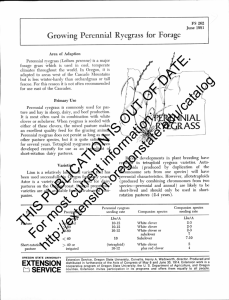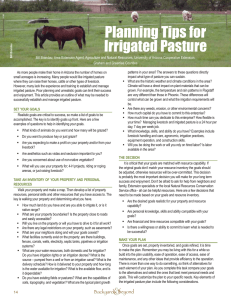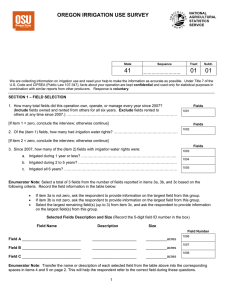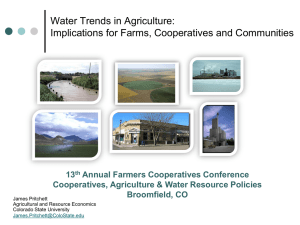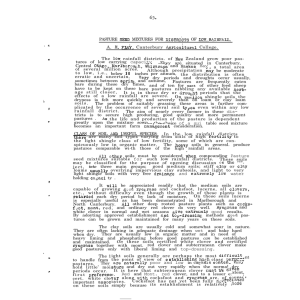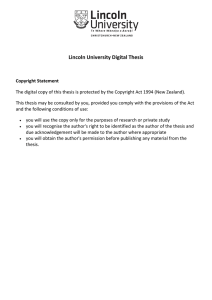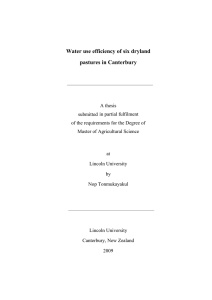S&E OBSERTiATIONS div IRRIGATED PASTIURES IN CANTERBURY -__I_ ._i-
advertisement
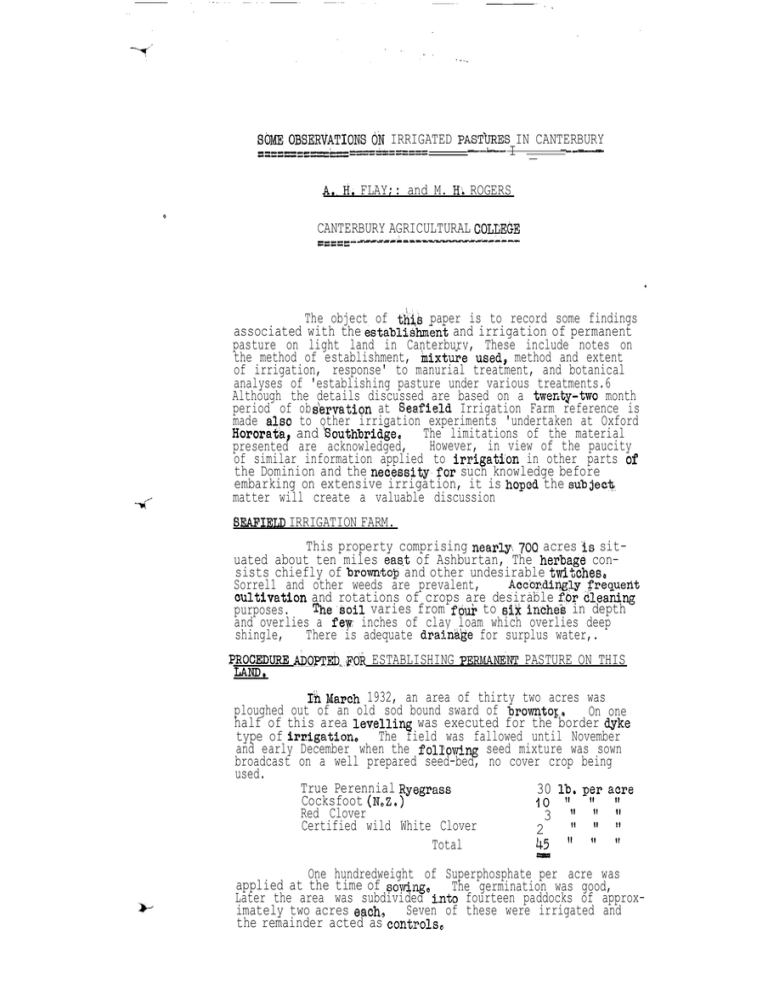
S&E OBSERTiATIONS div IRRIGATED PASTIURES IN CANTERBURY ._i--__I_ - zr;==~==~k - - I _ A..& FLAY;: and M. Hn ROGERS 0 CANTERBURY AGRICULTURAL C:OLCEGE ----r ,,,,,,,i-,,-,-,-,---~----w---------------------------- The object of th$,s paper is to record some findings associated with the establ&shment and irrigation of permanent pasture on light land in Canterbury, These include notes on the method of establishment, ktnixture used9 method and extent of irrigation, response' to manurial treatment, and botanical analyses of 'establishing pasture under various treatments.6 Although the details discussed are based on a twentytwo month period of ob servation at Seafield Irrigation Farm reference is made al,so to other irrigation experiments 'undertaken at Oxford Hoporata, and 'Southbridgec The limitations of the material However, in view of the paucity presented are acknowledged, of similar information applied to irrigati'on in other parts of the Dominion and the necessity,for such knowledge before embarking on extensive irrigation, it is hopod the subJe+ matter will create a valuable discussion SEAFIELD IRRIGATION FARM. This property comprising nearly'7OQ acres is situated about ten miles eas.t of Ashburtan, The herbage consists chiefly of browntop and other undesirable twitches& Sorrel1 and other weeds are prevalent, Accordir@ly,frequent oultivation and rotations of crops are desirable for cleaning The'Soil varies from fdur to six inches in depth purposes. and overlies a fev inches of clay loam which overlies deep shingle, There is adequate dra5nage for surplus water,. PROCZIXJRE AbOPTED..$?dk ESTABLISHING PERMAtiNT PASTURE ON THIS IAND* PnMarch 1932, an area of thirty two acres was ploughed out of an old sod bound sward of browntop., On one half of this area levelling was executed for the border dyke type of irfigation, The field was fallowed until November and early December when the folIowing seed mixture was sown broadcast on a well prepared seed-bed, no cover crop being used. True Perennial Ryegrass 30 1:. p;r afre Cocksfoot (NbZ,) 10 Red Clover 3 :: ;; :: Certified wild White Clover 2 45 " v' ') Total One hundredweight of Superphosphate per acre was applied at the time of sowings The germination was good, Later the area was subdivided into fourteen paddocks of approximately two acres each+ Seven of these were irrigated and the remainder acted as controls0 ---f -2- SUBSEQUFNT TREATMEM: x- OF THE PASTURES. In the autumn (I 933) an abnormally. dry period was experienced from mid-January until Mayo ‘The irrigated paddocks were watered five times between mid-February and early Thd total amount of water applied vas 8,13 inches9 May, 7. 38 inches from irrigation and 0,75 inches from rain@ From mid?February to May the frrigaUed areas were grazed harder than that usually recommended0 Since then,, however, the-,aystean of con&rolled rotational grazing has been more Weal, the sto& being shifted a day or so before really necessary. Some of these pastures were used for fattening Lambs in c?ne’ autumn9winter, grazing nas not attempted, During the dry spell the irrigat$d pastures showed striking ,superiori.ty in growth over the non-irrigated on which some young plants died, Cocksfoot and red and white clover appeared to be most seriously affected0 In the late autumn and winter the irrigated pastures This lack showed a pale yeiiow colour and appeared weakly0 of vigour was more pronounced on the areas. from which soil had been removed in. the proce& of levelling, The non-irrigated pastures 9 which had not yet been grazed, did not appear pale and yellow, and were ready for their f,irst grazing in August, The irrigated fields could not be grazed until mid-September, ' Aa the &ring advanced the appearance'of the irrigated pastures gradu.aH.y impy!'-c)vedC The improvdment was in keeping with, the amoun-i, of fer*:Zliser used0 (This will be’ dealt with later, ). fied and While c:Eover, ryegrass, ,and cod&foot, in that order, g;3zw vj,.gsx*oi.rsli.g from early October onwards0 As the spring weather cont.inued dry irrigation was carried out in October,- November a-r,d early December9 and ..cgain in April 193& The total quantity of vate:r received bv these grazed pastures .for the seaso (L?..;i'Ly j 93.3 %o June *I 93L~) was ~8~52 inches -‘-6,Ol inches, from irj5gaYLon. and 3Za5? inches from rain, had a.2 adverse effect on 6he nonespecially during Xovetiber and ecember, irrigated pastures, This effect con-i3nued. into January “. 934 even though ‘-3 inches of rain were recor'ded in Gle latter part of December and 3; inches in the first week of January@ T h e d r y sprl.ng ~~.I./,& TRp&qmw”‘?L ‘-1 pI From the time of sow.ing in November and December 193% to June 4934,. the manurial treatmen-~ps of the gfazed fields selected for’ botani& analysis are listed as f 0110~s :- .. dOther fields $eteived iiarious amounts of Supek and lime during the same period but on any one field the total quantity ’ applied did not exceed that $iVen the manured paddocks listed above o Observations showed that the application of fertilizer reduced during the winter, the degree of. the Rale yellow ap$earante already referred to and hastened recoveryi ', From October 1933 oncjards: a proportional increase in grow h 6f red., ana white clover was noticeable and bore a parallel re 1 a$ionshif! to the and, 5 dwt,of .Where 3 cwt. amount of manure applied; ryegrass,; and Carbonate of iime per acre per; annum was In the to a lesser extent Cocksfoot, more vigorous6 the clovers has been grazed pasture no smothering noteda BOTANICAL ANALYSk:OF IRRIGATED AND NON+-IRRIGATED GRA@D ZWRESQ I In the summer of 1 gj$& it $,W3 evident that : changes were taking place in the plant &tier .and to measure these the pin-point method of Analyses (4 ) was adopted0 an the irrigated pasture plots were pegged off where little or In each of the two no levelling or ling had been done. irrigated and non- rrigated fields selected three plots were used0 On each plot 25&pin points were taken making a total of 750. point6 for each field, Although counts were taken when .the grass and blover growth was about. the same stage of recovery after grazing it was not always possible to analyse the areas’ at the same time6 As shelter from a plantation and levelling caused variation in growth on about one half of the,.no-manure irrigated and non-irrigated fields botanical analyses were made in areas not affected by these factors0 The following table sets out the data obtained:-- T A,;,B L E I PERCENTAGE OF GROUND COVERED BY VARIOUS SPECIES CONTRIRUTING To THE SvwD OF DIFFERENTLY TREATED RAsTURES.;.;,.;: M A N U R,,E D .* N.0 - M A N U R E IIRRIGATED 1934 ;,FIELDS ,+an$i yegrass Cock& oot jhite clover ed Clover It1409 14.7 57 1805 9.5 2r3 Trefoil rowntop orrel Flat weeds Other weeds i are spaces 6.7 I al I 0.. 8 569 -r 19% Apri?O Trefoil Browntop Sorrel Iii-1 a4 -- Novt23 LS, 1712 ,i;i 14 Kl 1934 M&.24 405Q5 I.%'3 2630 oe3 lb9 1 *I I 934 5.3 II ml I,5 007 , Sepi24 I 933 10846 ;r5e6 6444 Apr. 21 73l .2 1934 1934 Sep.11 1 ‘40.: 8218 13.6 I 933 Dec. I 88,4 16,o 9..5 A.3 425 007 oe5 0*9 I 934 Apr o 21 87,2 %5 . 'E: z4 9.2 WI -- ,::z G-1 ii14 302 * See page 2 for manures applied. T- 1934 July27 62.~1 "7e2 906 809 I i?89 Ii7 001 1::: I 934 July 23 . ^ -+ -49 Wh$,le a perusal of this table shows that the plants have behaved according to experiences on bettqland with a Pavourable di,str$bution of rainfall it is significant so far that the growth of desirable species such as rgegrass, clovers and cocksfoot is being maintained and that an'influx ofundesirable plants is being prevented@ These findings are in agreemen$.with those of Trumble and Davies Sa Australia (2). Obseryation showed also that the density of the sward of herbage improved with irrigation and topdressingd In September 2933 'an irrigated topdressed'area was closed $or hay, Water was applied on ?3%h October (2.7 ins.) and 13th December (509 ins.),. Two cuts of hay were taken, the first on 6th December 1933, yielding 2,86 tons per. acre, and,the second on 28th February 1934 yielding loI 3 tons per acre - a total of 3.99. tons per acre0 Table II sets out the peroentages of the vari.ous species dontributing to the ground @over and,,Pbr 6omparison purposes analyses OF ,a similarly mariured~,i~rigaf'&d btit ag&tied area are indluddd:, 1 '. ., : '$,Q.,,k,$,,$i F "', t 1 . A '. ~EROENTJ&~~E OF GRC& COVERED BY VARIOUS SPECIES IN &,'Z)CB-DRESSED, IRRIGATED SWARD UNDER HAYING AND .I. GRAZING CONDITIONS, .: --f T ,. OUT FOR HAY 1934 Jan'y I ... GRAZ ED,: 1934 1934 April Septs 9204 ‘:;$e; 3% I-i15e:6 1 Se.5 9cr5 x7 -.-a ~~8. 204 203' 607 I 26*0 170: 1:I p-l 0,8 GoL4 108,6 1502 6404 509 ocl I el 204 003 e’ 12t This table shows that apart from an increase in Red Clover under haying conditions the two fields compare favourably in regard to ryegrass and other plants, This result is at variance with.the general belief that under average Canterbury conditions haying reduces the ground cover of ryegrass and weakens the pasture+ Possibly the .difference may be -attributed to the use of a permanent ryegrass.plus .irrigation. THE EFFEOT'OF RED AND WHITE CLOVER SEED.PRODUCTION ON THE OMPOS,ITION 0F.A MIXED IRRIGATED PASTUREb To- show the effectof red and white clover seed production on the-composition of a mixed irrigated pasture analyses were made in September l,934$ Five months after the crops were harvested* The data along with the analyses Of similarly treated hayed and grazed pastures are set out in : Table III, .‘e T A B.L E II? ; ‘X%rcentage.of gybund covered by various species oontr$*uting t&an frr.igated and topdressed mixed sjifard following .(.?) Grazing, (2) Haying, (3)White clovbr seed :pr,oduction, and (4) red”“c,lover seed ,’ produdtion I'. *,. ,, , . ! ': . ', _,,. 3./,'.' ;,. S E,P T E M B E R&34 y. ,, ,YI. 2,z:months after s'o$ing ,atid,Xs,,months after . , , oukxih~:,. .hay : &d.seed crops; I'. 7 1: j:'. sp&& , ,,, ."', ; 4 ' GRAg,? I': /;. HAY"-+ ?EIIT~EECOVZR RED;OVER : , k m . ! , a I . i.1, I. -, 9204 ,4&6” 36.4 8.8 I .6 7.2 32,O h1.6 'j I ;1 5 c 6 i/; j5.2 ?, -c 0.1 '; ::dt 5)*8 .‘; oj,j .r,4 " :/ j, ?" ,;, ;' ,', .I 2,4 1: 001 '._ 4.0 . 45.2 105.6 0.8 " ', : ;:8 " 8:o i-8 : I. ! 'Table I~~~:~'sho%s &hat cutting a mixed pasture for white :ar--redi.~~love~~~‘ti’dQ~, $&aves white an?! "red clover plants dominant, .X$ C% "~~~~.~o~s$&!@'h &tit. the nottible 'reduction in ryagrass fcllowIri9.,,'~'su~~:.;~i,~~~~~~t 8 is due'in a,large <e&sure to smothering., ;... ', . T,I‘ '. ,-i'..' I "&;,.' ;. '. '. ~~,,~~~.;IR~~~~~~'E~.,,,~~ST:~RE~ :+oTHE*R pfj~Ts OF CANTERBURY .:...., 1 '.!.'.';,: ; : .jl 7 ; ,,:y: ,i.' "' '!_ !. ','. ,'. . ',A$'$&r$&"ca;cuid~ bxford~ne%:ptistu.res were sewn 'for i rriga tio~,,~p$&&$~& 'Phe prep&r&t%on CC seed-bed., times' of saw$rig, seedingj&d manuring, w&k much the same as for SeaIn the&&.'$$ti districts observations showed that field, during the autu$&(rl~9$3) these irriga.ted pasturesgrew strongly and g$!@:.high carrying capacities, During the late autumn,and wint&,they were pale And weakly, As the spring advanced this po@l&pearance gradually gave way to a better giwtith, aspecialljr .!W c30verso I #: ; At '0&3&&h' (mid-way'botween Bouthbridge and Rakaia) an establi:shed, ryegrass and subterra&an clover pasture was irrigate,$&i'":Y R,e-egtabl:;shment of the 'subter,ranean clover in early autukth ,gave gcqd: late aututn~, -.virinter tind spring. . growth, ? f; .‘, :-‘J. The chie~~',~~asonlfor,,referriri~ to the: irrigation e,xper$m&ts at Oxford and,.;tioro,kata is-to show that thepale ~~ellow d%so;"Flouratioii:,and w@k.gr&th cf. the.herbtige during es$kbIishinent wss~%dt 'O6#'fne,$. to the 'S~af.ield.pasture'sb~~tcccurs &3 wbll,~$,ut t&a iedser extent,, 'cn non-irrigated pa,stures 'sown in lat.&,.spr$ng"tind ear3.y summer,, i. '. j:, ;. ., Th&act'$ha$ topdressing red&es ',the degree of discolcur.@t$& i$tid,si&ik&,ping suggests that soil &tiIi$v $8 'a d&&&g,f~g$& J;n“i.ts development, ',I+ tiupport cf this vi&? it w&i, natio&abIe ‘that herbage ,onpatches filled'in to, 8 de@& cf two;: &&c&e @.&et during!,l;evelling .was notaffected, wh&reas j.n &eas'where'soil was &jjind~ed.a: marked',preyalence Cf In &$f&;r@, ,.discclou$&tioZ$ ,&d the >@nditi.& was',;'evident. n6t &cup in these; pastures in'the:l'ate autumn,&d W+t.tX'~f '. * I’ . .4 .. --y -6- , 19% even though 1s inches more water were than when discolouration occurred,, received per month CONCLUSION,, " ,The information presented shows certain effects of. i,.rri,gation, manuring, grazing, haying, and-red and white 6~6~B~'seed,production on the botanical analysis and apyearan& & irrigated mixed pastures at Seafield, ;: : R@'ERENCES.., .., _' 61) Levy & Madden: N.2, Jour,of PP~ (2)'Trumble & Davies: Agric. 267 +i’9 ,. Vo1.46. May 19339, Bull, No,80 Commonwealth Council for Scientific & Industrial Research; .. .’ -. ” +-l-d-++++++-I-++ ++++-+++ +-I+ YIELD. ack Skinless Barl,ey a.nd Vetches. ape Barley and Vetches, ack Skinless Barley and I t a l i a n Ryegrass, Cape Barley and Italian Elyegrass, ( OLD IN TONS (~333~ YEIGHT) D .
